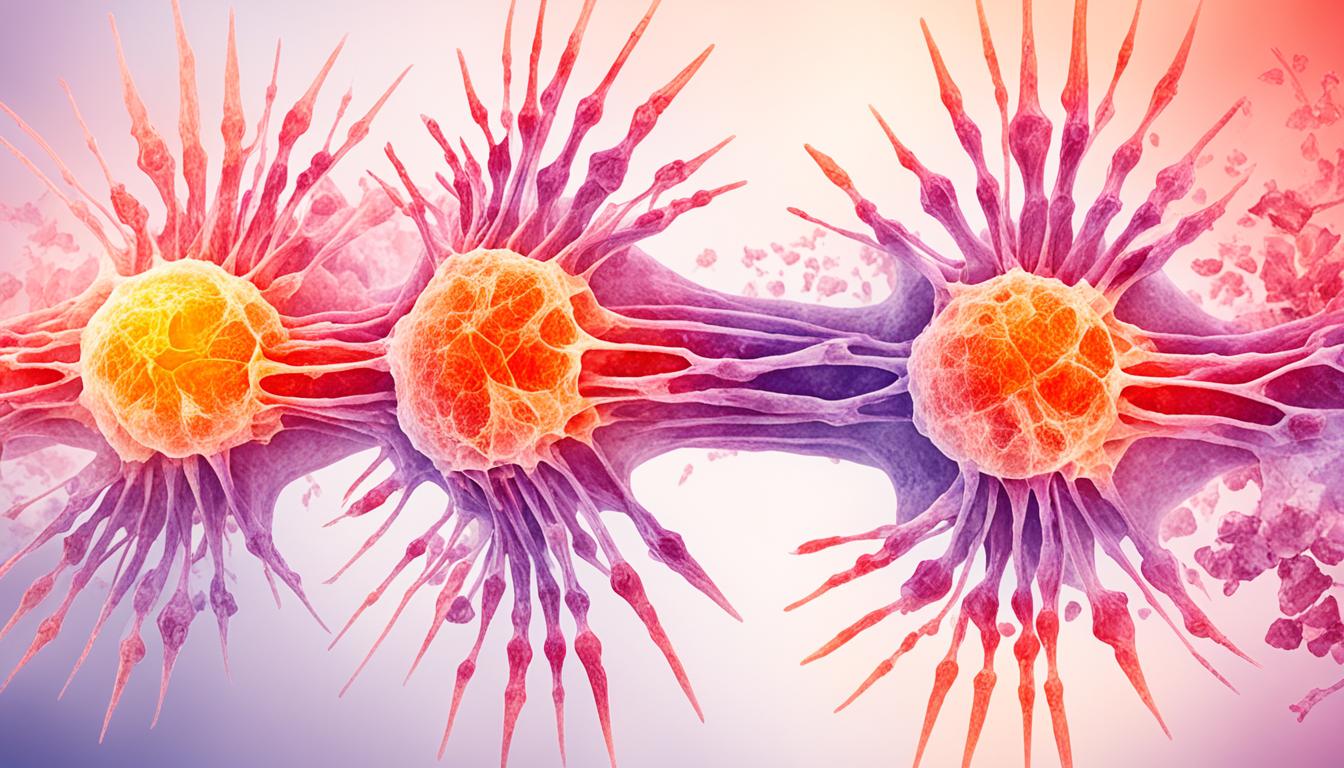Pseudogout is a type of arthritis. It causes a sudden onset of pain and swelling in a joint. It is caused by depositing calcium pyrophosphate dihydrate (CPPD) crystals in the joint. Common symptoms are pain, swelling, and redness in the joint. The knee is usually affected.
Age, genetics, and certain health conditions increase the risk of pseudogout. This includes hemochromatosis, hypothyroidism, and hyperparathyroidism. It can cause severe joint pain and reduce quality of life during flare-ups.
To diagnose pseudogout, doctors look at joint fluid for CPPD crystals. This is done through a procedure called arthrocentesis. It confirms the diagnosis and checks for other causes of joint pain.
Treating pseudogout focuses on easing pain and inflammation. Doctors often use NSAIDs, colchicine, steroids, and pain relievers. But, if these treatments aren’t enough, stem cell therapy might help.
Stem cell therapy uses cells that can change into different cell types. This can help repair and regenerate joint tissue. While it’s still being researched, it has shown to reduce inflammation and pain, and improve joint function.
If you’re looking into stem cell therapy for pseudogout, talk to a specialist. They can give you advice tailored to your case. This includes the possible benefits and risks of the therapy.
Key Takeaways:
- Pseudogout causes sudden pain, swelling, and redness in a joint.
- It happens when CPPD crystals form in the joint.
- The knee is often affected, but any joint can get pseudogout.
- Risk factors include age, genetics, and certain health issues.
- Diagnosis checks for the presence of CPPD crystals in joint fluid.
- Treatment aims at lessening pain and inflammation with drugs.
- Stem cell therapy may help with tissue repair and joint healing.
- Seeing a specialist in stem cell therapy is recommended.
Symptoms and Causes of Pseudogout
Pseudogout starts suddenly with pain, swelling, and redness in a joint. Symptoms hit their worst in 24 hours and can last over a week. The knee is often affected, but other joints can have pseudogout too.
The main cause of pseudogout is the buildup of CPPD crystals in the joint. It happens for different reasons, and not everyone gets pseudogout. The exact cause is not clear yet.
Several things may raise your chance of getting pseudogout:
- Being over 60 years old
- Having a family history of pseudogout
- Having too much iron in your blood
- Thyroid not working well
- High levels of parathyroid hormone
- Kidney problems that affect calcium
- Not drinking enough water
Knowing these risk factors can help you avoid pseudogout or lessen its impact. If you think you might have pseudogout, see a doctor for tests and a care plan.
Risk Factors for Pseudogout
| Age | Genetics | Hemochromatosis | Hypothyroidism | Hyperparathyroidism | Certain Kidney Diseases | Dehydration |
|---|---|---|---|---|---|---|
| Increased likelihood in individuals over the age of 60 | Certain genes may increase susceptibility | Excess iron in the body | Underactive thyroid function | Elevated levels of parathyroid hormone | Kidney dysfunction affecting calcium excretion | Inadequate hydration |
Diagnosis and Treatment of Pseudogout
Diagnosing pseudogout involves a procedure called arthrocentesis. This step identifies CPPD crystals in the joint fluid. Doctors then look at these crystals under a microscope. This confirms if a person has pseudogout.
The main treatment goal for pseudogout is to lower pain and inflammation in the joint. Several medications and methods can help here. It includes using NSAIDs and colchicine to manage symptoms. These work by reducing swelling and relieving joint pain.
Another medication that helps is colchicine. It stops the body from making substances that lead to pain and swelling. Steroids may also be given to reduce symptoms fast.
Doctors sometimes also withdraw fluid from the joint. This can remove crystals and offer quick pain relief. Steroids might be put in the joint during this process to help feel better.
If someone often gets pseudogout attacks, they might take colchicine daily to stop future episodes. This aims to keep the inflammation low, which decreases the chances of getting pseudogout again.
It’s also key to treat any diseases linked to pseudogout, like hemochromatosis or thyroid issues. Treating these can reduce the risk of pseudogout and make managing it easier. A complete treatment plan is essential to live well with pseudogout.
Stem Cell Therapy for Pseudogout
Stem cell therapy is promising for those with pseudogout. It uses the regenerative power of stem cells to help repair and grow tissue in the joint. While still being studied, it shows good results in joint issues like pseudogout.
Stem cells have the power to decrease swelling, boost joint movement, and lessen pain. They can change into various cell types for fixing the joint. More research is needed to check on how well and safe this treatment is for pseudogout.
Thinking about stem cell therapy for pseudogout? It’s important to talk to a specialist first. They can give expert advice and look into what this therapy might do for you. Stay updated and start your path to ease pseudogout with the help of new stem cell treatments.

